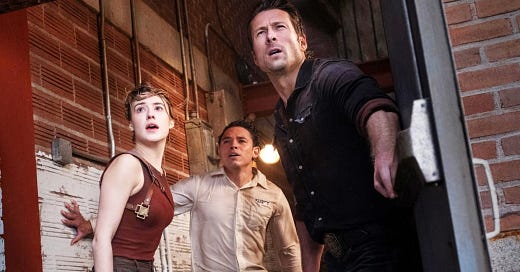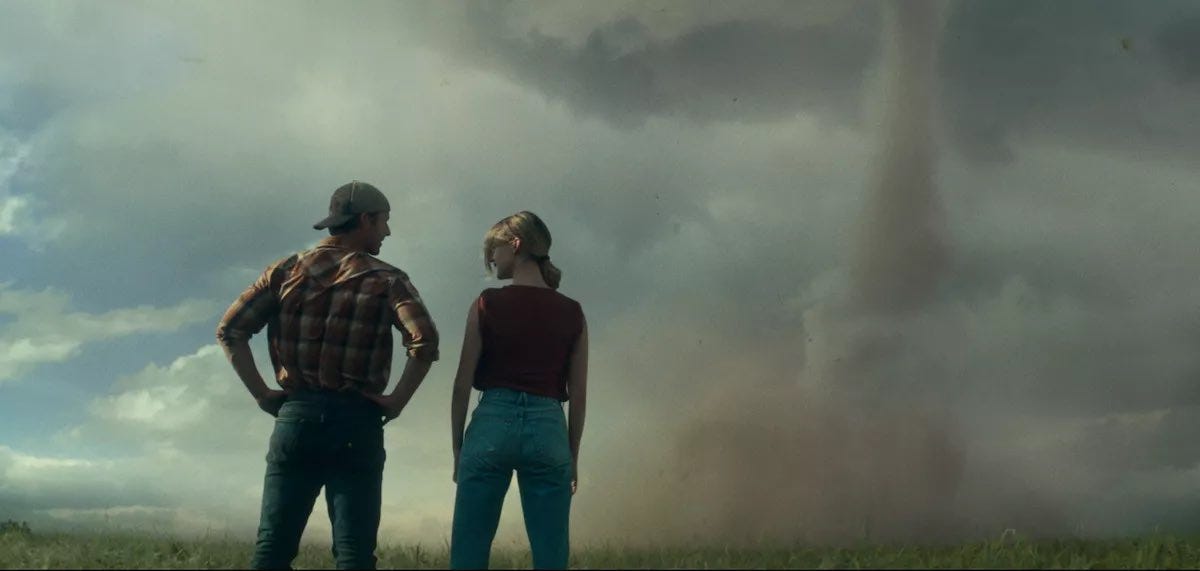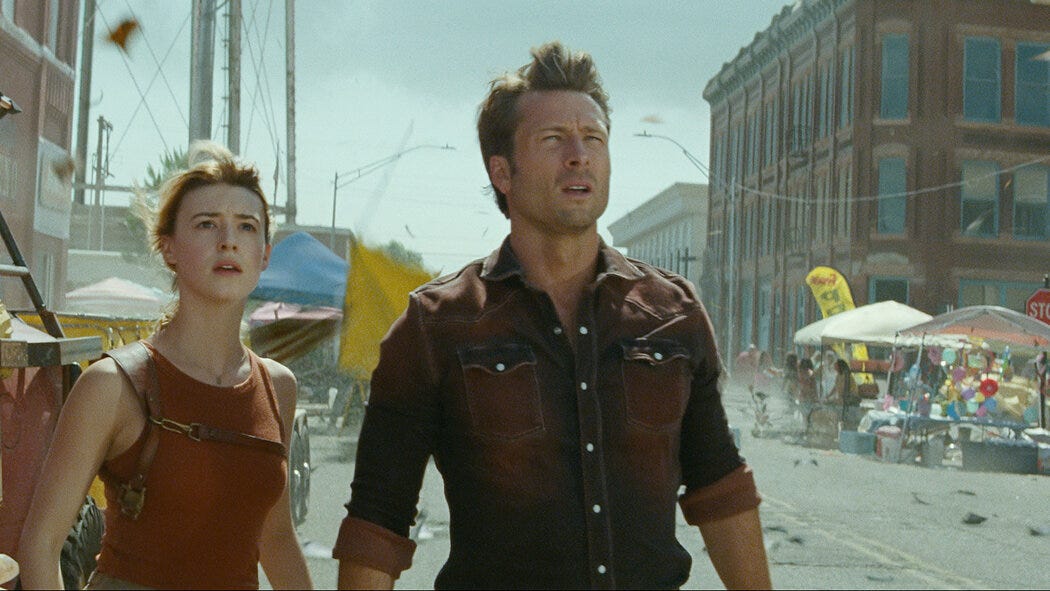The original Twister came out at the perfect time for me: in May 1996, right around the time I was finishing sixth grade, when I was first getting into movies and dutifully watching everything on AFI’s list of the hundred greatest films of all time. (In retrospect, not the most accurate barometer of cinematic artistry, but it was just the thing for a nascent, twelve-year-old movie lover.) Twister was old-fashioned popcorn entertainment, with groundbreaking (and seat-rattling) sound design that felt pleasantly like your eardrums might pop at any moment. It might not be a masterpiece on its own terms, but it’s easy to look back on Hollywood movies from the 1990s and cherish their visual beauty (compared to today), their eagerness to please, their innocence before the studio system was hobbled by digital technologies, streaming platforms, and the like.
In a way, the quasi-sequel Twisters came out at just the right time, too. With some notable exceptions (like Top Gun: Maverick and the Mission: Impossible movies), Hollywood’s ability to wow audiences seems spottier than it used to be. Part of that can probably be blamed on the fact that many people see movies at home instead of in theaters now, so the magnitude of a larger-than-life screen and a thunderous sound system isn’t the draw that it used to be for moviegoers. Of course, the content of such movies is also lacking, with big-budget films often resorting to rote comic-book storylines. My faith in Hollywood is shaken, in other words, but Twisters goes a long way in restoring it, or at least it did for two blissfully escapist hours. While it appears to be a sequel on the surface, it might more accurately be called a spinoff; aside from their general subject matter and title font, the two films don’t have much connection to each other. And even though Twisters features plenty of CGI, it’s generally secondary to the story and the characters; in fact, the special effects are subordinate to good old-fashioned visual storytelling, a welcome change of pace from the original.
Twisters’ narrative may not sound especially audacious. It follows Kate Carter (Daisy Edgar-Jones), an Oklahoman who studies meteorology and forms an upstart storm-chasing crew with her friends. A thrilling prologue shows Kate and her gang attempting to unleash sodium polyacrylate into a tornado to dissipate its moisture and lessen its intensity, but the attempt fails, lives are lost, and Kate’s formative trauma is established.
Years later, Kate has taken to working at a NOAA office in New York City, as far as possible from Tornado Alley. But a reunion with one of her former friends, Javi (Anthony Ramos)—the only other member of their one-time storm-chasing crew to survive—compels her to return to Oklahoma for a week and try out a new data-collection system on behalf of a tornado-monitoring company called Storm Par. Unable to resist the chance to further develop her research (and possibly aid some small towns directly in the path of oncoming storms), Kate goes back home to contend not only with twisters but also with her personal demons.
Back in Oklahoma, Kate encounters an obnoxious squad of celebrity storm-chasers called the Tornado Wranglers, led by impossibly handsome Tyler Owens (Glen Powell). The Wranglers have made a name for themselves on YouTube, where their channel has almost a million subscribers. At first glance, it seems like Tyler and his cohorts are exclusively concerned with training the cameras on themselves and ignoring the science of tornados to focus on their spectacular, attention-grabbing qualities. But as Kate grapples with the motivations of Tyler, Javi, and herself—and as she finds herself irresistibly drawn to Tyler (to the surprise of no one in the audience)—she finds that first impressions can be deceiving.
The story works not because of its originality, but because the film treats it with surprising depth and sincerity. Against all odds, Twisters is character-driven, with the tornadoes providing background flavor rather than serving as the primary attraction. The conflicting motivations that drive Kate, Tyler, and Javi to pursue their passion are revealing. Kate is in it for the science: understanding the untamable beasts that are twisters and trying to use that knowledge to lessen their devastating impacts. On the surface level, Tyler appears to be in it for the fame and success, though his apparent narcissism (including his face plastered all over t-shirts, coffee mugs, and other merchandise) has a deeper motive. Similarly, Javi’s nice-guy altruism masks a more desperate and money-driven impulse. The point is, these motivations shift all the time, and Twisters makes the unexpected point that it’s possible to do what you love for the wrong reasons as well as the right ones. The passion in question here is chasing storms, but the theme can be applied to any other vocation—like, for example, blogging about movies or writing creative fiction, fields in which it’s all too easy to lose sight of the spark that drove you in the first place.
Twisters is also appealing in its ardent belief in the power of science, a delightfully nerdy approach that pays tribute to the climatologists and meteorologists trying to contend with an increasingly erratic natural world. This is a movie in which one of the most exciting scenes follows Kate and Tyler as they painstakingly rework a 3D model to demonstrate how capsules of sodium polyacrylate might interact with the moisture in a funnel cloud. Other scenes go into a modicum of detail about radar technologies, cloud formations and wind patterns, and the logistical question of where to take shelter if there are no basements nearby. It’s a pleasure, essentially, to see a populist movie in which the characters’ intelligence is seen as their most attractive quality.
This, finally, is connected to another of Twisters’ admirable traits: its veiled allusions to climate change. Although some have decried the movie’s unwillingness to mention climate change directly (operating under the illusion that every theme in a work of art has to be voiced explicitly), it’s impossible to miss the point with all of the film’s dire mentions of increased tornadoes, flooding, wildfires, hurricanes, and the growing challenge in tracking them accurately. The entire underlying suspense of the film is that there’s an urgent real-world impetus to monitoring these storms and mitigating their destruction—as is made clear in several scenes in which Kate, Tyler, and others hand out resources to communities devastated by weather disasters. If that doesn’t automatically conjure the horrors of climate change for some viewers, I think that says more about them than about Twisters itself. Indeed, if the film had repeatedly speechified about climate change, it surely would have received criticisms that it’s clunky sermonizing masquerading as entertainment. Again, one of the things I find most pleasurable about Twisters is how character-driven it is—and obviously, those characters would have an intimate understanding of global warming and the pressures it places upon our planet. Far from avoiding mention of this issue, Twisters makes it a conspicuous subject and an unavoidable subtext.
I confess I haven’t seen Lee Isaac Chung’s previous film, the acclaimed Minari (2020), though it’s interesting that it also seems to focus on the American Midwest and the importance of family (which Twisters does in a charming sequence featuring Maura Tierney as Kate’s mother). Maybe the more nuanced characters and sublayer of themes can be attributed to his presence behind the camera. My response is an anomaly, apparently: most critics responded to Twisters tepidly at best, with Alison Willmore’s review for Vulture summarizing the overall view: “[The] compulsion to reverse engineer serious stakes for a fundamentally frivolous story is Twisters’ most contemporary quality and its most irritating.” (No disrespect to Willmore, a writer I greatly admire and whom I usually agree with.) Are my expectations of Hollywood so deflated that I respond enthusiastically to an intelligently made blockbuster with signs of visual composition, engaging characters, and thematic sophistication?
In the end, maybe I have to admit that Twisters came out at the perfect time for me personally. Near the end of a brutal summer filled with emotional hurdles and professional disappointments, here was a visit to a multiplex that harkened back to a time when falling in love with movies was simple and all-consuming. Twisters may not break the mold, but it’s a satisfying mold to begin with—it left me leaving the theater with a contented grin on my face. That’s a minor miracle that would be ungrateful to overlook.






